Abstract
High-temperature strain gauges are widely used in the strain monitoring of the hot-end components of aero-engines. In the application of strain gauges, the calibration of the gauge factor () is the most critical link. Evaluating the uncertainty of is of great significance to the accuracy analysis of measurement results. Firstly, the calibration test of the of the Pt-W high-temperature strain gauge was carried out in the range of 25 °C to 900 °C. The real test data required for the uncertainty evaluation were obtained. Secondly, the guide to the expression of uncertainty in measurement (GUM) and the Monte Carlo method (MCM) were used to evaluate the uncertainty of calibration test. The evaluation results of GUM and MCM were compared. Finally, the concept of the weight coefficient was proposed to quantitatively analyze the influence of each input on the uncertainty of the output . The main uncertainty source was found, which had important engineering practical significance. The results show that the mean value of decreases with the increase in temperature nonlinearly. At 25 °C, is 3.29, and at 900 °C, decreases to 1.6. Through comparison and verification, the uncertainty interval given by MCM is closer to the real situation. MCM is superior to GUM, which only uses prior information for uncertainty assessment. MCM is more suitable for evaluating uncertainty. Among multiple uncertain sources, the weight coefficient can effectively analyze as the main uncertain source.
1. Introduction
Aero-engines are complex and precision thermodynamic machines. To ensure the normal operation of engines in extreme working environments such as high temperature, high pressure, and strong vibration, it is necessary to monitor the stress and strain generated by the hot-end components timely, accurately, and stably [,]. Therefore, convenient, effective high-temperature resistance strain gauges with high precision have emerged. In the development and application of high-temperature strain gauges, GF calibration is the most crucial link [,]. Measurement uncertainty is an important parameter to characterize calibration quality.
In the calibration test of high-temperature strain gauges, is affected by various physical factors such as the fabrication, installation, and testing of the strain gauges [,,]. Therefore, there are many uncertainty factors in the calibration test. Uncertainty evaluation is a key step in the test work, without which the scientific conclusion cannot be drawn. Due to the complexity of the environment where strain gauges are located, the quality of strain measurement data has always been a concern in the aerospace field, but there is no unified evaluation standard []. Currently, through traditional statistical methods, the mean and variance of can be obtained, and then the dispersion interval can be obtained. However, there are few studies on the evaluation of the uncertainty of calibration tests. There are two main methods for evaluating measurement uncertainty. One is the “Uncertainty of Measurement—part 3: Guide to the Expression of Uncertainty in Measurement (2010)” (GUM) based on the law of propagation of uncertainty []. This method is the most widely used and easy to operate, but it is mainly applicable to linear models and has certain limitations []. Hayat El Fazani et al. conducted tensile tests on additive manufacturing specimens and analyzed the uncertainty of the specimen’s performance with GUM []. Yingming Chen et al. evaluated the monitoring uncertainty of the high-speed rail long-wave timing system based on GUM []. Song Mingshun et al. used Bayes’ theorem and GUM to assess the measurement uncertainty of small samples. By comparison, Bayes’ theorem was more reliable than GUM [].
Another uncertainty assessment method is the “Evaluation of Measurement Data—Supplement 1 to the Guide to the Expression of Uncertainty in Measurement—Propagation of Distributions Using a Monte Carlo Method (2008)” (Monte Carlo method, MCM) [,]. Jiang Wensong et al. used MCM to establish an evaluation model for the parameter calibration uncertainty of a 6-DOF manipulator. Through a large number of random numerical simulations, the uncertainty evaluation of the manipulator calibration was realized []. Huang Meifa et al. used MCM and an improved quasi-MCM to simulate and assess the uncertainty of cylindrical volume measurement and compared the results []. Jasveer Singh et al. used MCM to evaluate the uncertainty of the effective area of the pressure balancer and analyzed the influence of the input probability density function (PDF) on the output PDF []. Marius Forster applied MCM to the estimation of the local measurement uncertainty in transient heat-transfer experiments, demonstrating the advantages of MCM while considering nonlinearity and local uncertainties []. Kerstin Rost evaluated the measurement uncertainty of the gear measuring instrument by MCM and extended the mathematical model during the measurement process []. H.B. Motra applied MCM to evaluate the measurement uncertainty of material property and provided mathematical and calculation tools for the quantitative assessment of the quality of measurement results [].
However, it is difficult to determine whether the above two methods are applicable in specific fields. Many scholars have compared and verified GUM and MCM in their respective fields. Saeid Sepahi-Boroujeni evaluated the uncertainty of the internal detection point set of the five-axis machine tool based on GUM and compared it with the MCM evaluation result []. Wang Wei et al. presented the principle and procedure of evaluating the measurement uncertainty of complex models by MCM and GUM and compared the two assessment methods with examples []. H.F.F. Castro introduced a method for calibrating small verifiers using the weighing method, evaluated the uncertainty of verification by GUM and MCM, respectively, and verified the validity of GUM by MCM []. Andrew Chen developed a sweat measurement system in the biomedical field and evaluated and compared the measurement uncertainty with GUM and MCM. The assessment result of GUM provided useful information for improving the measurement performance, while MCM could not evaluate it [].
At present, in the calibration test of , the output is analyzed by traditional statistical method []. The high-temperature strain gauges are expensive, and the number of samples obtained by the test is small. The dispersion obtained by the existing statistical method cannot represent the overall characteristics, which directly affects the analysis accuracy of the test results and cannot reflect the influence of the input on the dispersion. Uncertainty is an important indicator to characterize the quality of measurement results, but there are few studies on the uncertainty evaluation of calibration tests.
In order to solve the above problems and find a more suitable method for uncertainty evaluation, this study was carried out. In this paper, the calibration test of the high-temperature strain gauge was carried out in the range of room temperature to 900 °C, and the real test data were obtained. The mathematical model was established. The uncertainty of strain gauge was evaluated by GUM and MCM methods, respectively. The MCM is based on the theorem of large numbers and is used to verify the GUM evaluation results. The results show that GUM method is not suitable for evaluating the uncertainty of calibration test of strain gauge. The concept of weight coefficient was proposed, which can quantitatively analyze the influence of each input on the uncertainty of . It is a good supplement to MCM and has important practical significance in engineering.
2. Mathematical Model
In the calibration test of the high-temperature strain gauge, plasma-sprayed ceramic Al2O3 is used to install the strain gauge on the specimen and connected to the strain meter. The specimen and support are placed in the high-temperature furnace, and heated step by step according to a certain temperature rise rate and temperature interval. Heat preservation is measured at each calibration temperature point, and then loading and unloading are assessed three times []. The data are recorded by external trigger mode. The schematic diagram of the calibration test of the high-temperature strain gauge is shown in Figure 1.
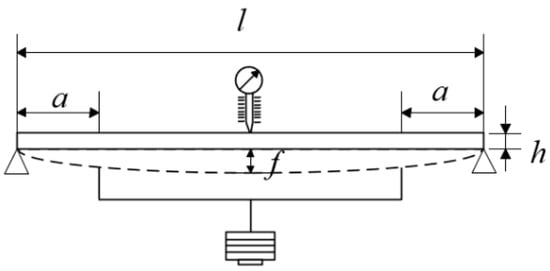
Figure 1.
GF calibration test device schematic.
According to Hooke’s law, the surface strain at the midpoint of the specimen can be calculated by measuring the midpoint deflection, as shown in Equation (1):
where is the thickness of the specimen. is the distance between the two fulcrums. is the distance between the loading point and the fulcrum. is the difference in deflection between loading and unloading.
In order to avoid the error caused by direct measurement of resistance changes, a strain meter is used for strain measurement. The of a single strain gauge can be calculated from Equation (2):
where is the gauge factor that needs to be measured and calibrated. is the initial gauge factor of the resistance strain meter, usually . is the difference between the indication value of the strain meter during loading and unloading. The mathematical model of the calibration test is obtained by substituting Equation (1) into Equation (2), namely Equation (3):
3. Evaluation Principle
At present, in the field of measurement, GUM and MCM are the main methods for evaluating measurement uncertainty. However, in the calibration test of strain gauge GF, it is difficult to judge whether the two methods are applicable, and the evaluation results need to be analyzed and compared.
3.1. GUM Evaluation Principle
3.1.1. Calculate the Standard Uncertainty
According to the measurement experience, the uncertainty evaluation methods of each input are classified into two categories: A and B. Category A is for quantities that are measured repeatedly, and Class B is for empirical probabilities. is evaluated according to Class A. In the calibration test, there are six strain gauges attached to the upper surface of the specimen. In the heat preservation process of each temperature point, loading and unloading are carried out three times [,], and the 18 measured values of the input quantities are obtained. represents the mean value of , and the standard deviation of can be calculated by Equation (4):
where is the number of strain gauges, . is the number of loading and unloading times, .
The standard uncertainty of is calculated according to Equation (5) []:
The uncertainty of , , and in the mathematical model are calculated according to Class B assessment. The standard uncertainties of the input quantities are calculated according to Equation (6):
where is the half width of the interval. is the inclusion factor.
Generally, at room temperature, the uncertainty resulting from the maximum allowable error of a measuring instrument, usually assumed to be uniformly distributed []. , , and is taken. With the increase in temperature, when the measured value is affected by a variety of random quantities, it is approximately a normal distribution, .
In the test, the deflection is measured three times. The number of measurements is small. The standard uncertainty of is calculated by the range method and is obtained from Equation (7):
where is the number of loading and unloading times, .
3.1.2. Calculate the Combined Standard Uncertainty
According to the mathematical model Equation (3), input and are independent of each other. The combined standard uncertainty of the gauge factor is calculated by Equation (8):
Calculate the expanded uncertainty
where is the coverage factor. In the usual measurement, is generally taken. When taking other values, the source should be stated [].
3.2. MCM Evaluation and Verification Principle
3.2.1. MCM Evaluation Principle
The numerical characteristics of input quantities are calculated from the obtained real test data. In the MATLAB R2021a software, rand() can generate uniformly distributed random numbers. The generator normrnd() can generate normally distributed gaussian numbers. At 25 °C, the uncertainties of the input quantities , , and are determined by the maximum allowable error of the measuring instrument, which is assumed to follow a uniform distribution. The input quantities and are measured using dial indicator and strain gauges, and are assumed to follow gaussian distribution. As the temperature rises, , , and are affected by many random factors, such as length, temperature difference, thermal expansion coefficient, etc. [,]. Therefore, it is assumed to follow a normal distribution.
The principle of MCM is the PDF of each input is propagated through the model to obtain the PDF of the output , as shown in Figure 2. The estimated value, the standard uncertainty, and the coverage interval of are obtained by further calculation.
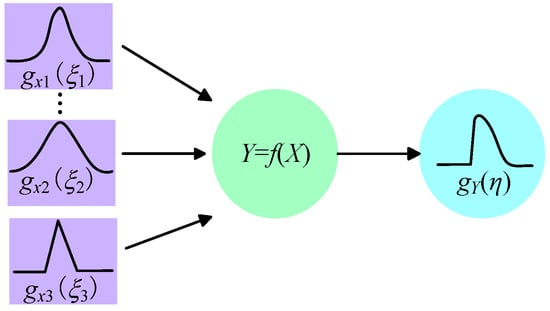
Figure 2.
Schematic diagram of MCM distribution propagation.
The sample size of the input should satisfy , where is the coverage probability. When , , and the sample size is taken.
3.2.2. Verifying GUM by MCM
Although GUM is suitable for many situations, it is very difficult to determine whether it satisfies the applied environment. Because the basis of MCM is the large numbers theorem of probability theory and the application scope is wider, MCM is used to verify GUM. The endpoint deviation values and are calculated, respectively, according to Equations (10) and (11) []:
In the formula, is the endpoint value of the coverage interval of the output obtained by GUM in probability . and are endpoint values of the probability symmetric coverage interval obtained by MCM. Take as the numerical tolerance of the standard uncertainty . If and , the GUM passes the verification, otherwise it fails.
4. Calibration Test and the Evaluation Results
4.1. Calibration Test System
In the calibration test, the specimen is made of DZ125L, a nickel-based superalloy material commonly used in the hot-end parts of aircraft engines. The size of the specimen is 400 mm × 30 mm × 6 mm (length × width × thickness). The high-temperature strain gauge is made of Pt-W alloy grid wire containing 9% W. The grid size of the strain gauge is 3.18 mm × 3.18 mm, and the nominal resistance is 90 Ω. In order to reduce the influence of environmental errors and obtain as many measurement samples as possible, six strain gauges are installed along the axial direction on the upper surface of the specimen. The gauge factor test device is shown in Figure 3. The system consists of a high-temperature heating furnace, temperature controller, loading device, strain gauges, thermocouples, specimen, resistance strain meter, dial indicator, and related computer.
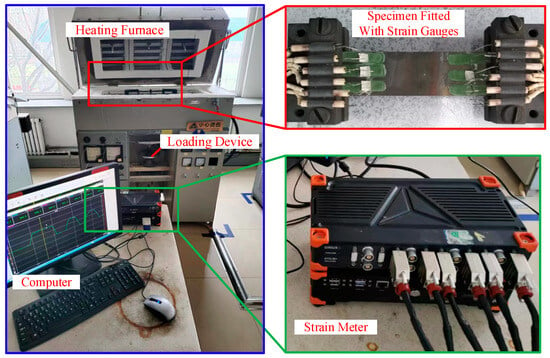
Figure 3.
Schematic diagram of test system.
The armored thermocouple of the specification is Φ1 mm, type K was used for temperature measurement, and the measurement accuracy is ±1.5 °C. The thermocouple was installed near the strain gauge and the temperature signal was fed into the DEWESOFT-STGM data acquisition (DEWESOFT Co., Kumberg, Austria) instrument through the DSI-TH-K adapter (DEWESOFT Co., Kumberg, Austria) to realize the simultaneous measurement of temperature and strain. From 25 °C up to 900 °C, the selection of test nodes needs to take into account the capacity of the equipment and the test period, so the equal interval selection of 100 °C was carried out. The calibration points were set as 25 °C, 200 °C, 300 °C, 400 °C, 500 °C, 600 °C, 700 °C, 800 °C, and 900 °C. After reaching a constant temperature point, the constant temperature was maintained for more than 15 min to ensure a uniform temperature between the measurement points. The force was loaded through the combination of weights and mechanisms for raising and lowering weights. The loading was stopped when the surface strain of the specimen reached 1000 ± 50 με, and then the test data were recorded before unloading. The Keyence GT2-P12 displacement meter (Keyence Co., Shanghai, China) was selected for deflection measured, the test accuracy is ±1 μm, and the current signal was connected to the DEWESOFT-STGM data acquisition instrument. The temperature was kept constant, and the loading and unloading operations were repeated three times.
4.2. Test Results
In the calibration test, six strain gauges were installed on the upper surface of the specimen. The load was applied three times at each calibration temperature point to obtain three different deflections . Each deflection value corresponds to six measured values of . The measurement results are shown in Figure 4. At different temperatures, the specific data of strain measurement for loading and unloading are shown in Table A1. The uncertainties of , , and are determined by the maximum allowable error of the measuring instrument. Based on the real data from multiple measurements, the uncertainty is evaluated according to the mathematical model.
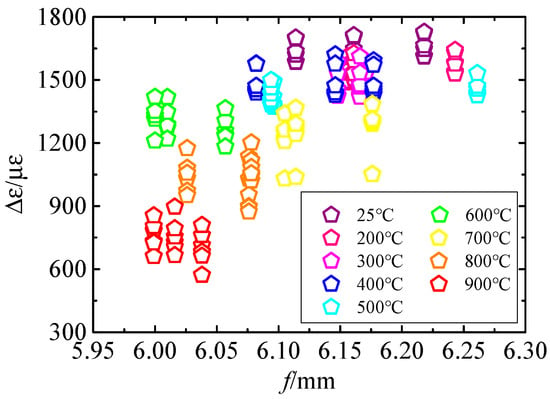
Figure 4.
The relationship between the measured value of the strain gauge and the deflection.
Based on the experimental results, the gauge factor of the six strain gauges at different temperatures are calculated, respectively. The results are shown in Figure 5, which shows that gradually decreases with the increase in temperature. When the temperature is 25 °C, is approximately 3.29, and when the temperature rises to 900 °C, decreases to 1.6. When Pt-W is used as the sensitive grid wire material, decreases with the increase in temperature. The experimental results are in accordance with this basic law.
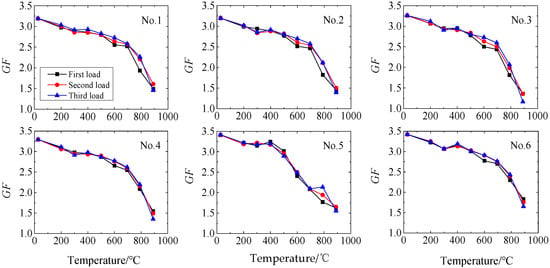
Figure 5.
GF of strain gauges at different temperatures.
4.3. Evaluation Results of GUM
The uncertainty analysis of at different temperatures is conducted using GUM. The measurement results can be expressed as , where is the estimated value, and is the half width of the coverage interval of at 95% probability. The uncertainty of each uncertainty source and the combined uncertainty at different temperatures can be calculated from the formulas in Section 3.1. The results are shown in Table 1.

Table 1.
The uncertainty of each uncertain source.
According to the calculation steps in Section 3.1, the estimated values and uncertainty intervals of can be obtained at different temperatures in the range from 25 °C to 900 °C, as shown in Figure 6. It can be seen from the figure that the estimated value of decreases with the increase in temperature, which is consistent with the trend of each strain gauge. The uncertainty interval is narrow, and the dispersion at 800 °C is 49.3% higher than that at 700 °C, and the interval variation is unstable. Therefore, MCM analysis is required, and GUM results should be verified.
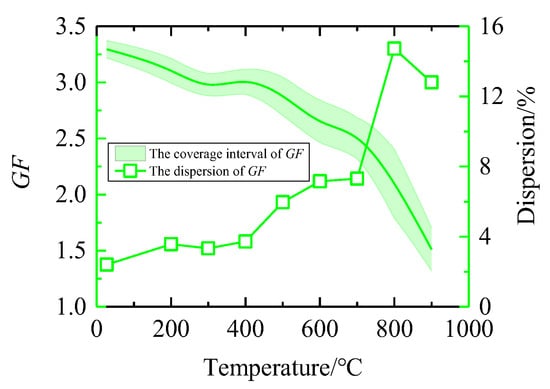
Figure 6.
Uncertainty interval and dispersion of obtained by GUM.
4.4. Evaluation Results of MCM
Based on the test data, MCM is used to simulate and analyze the test results in MATLAB software. At 25 °C, frequency distribution histograms of random numbers such as , , , , and are shown in Figure 7, and the number of samples is 106. In a high-temperature environment, each input is affected by a variety of random factors such as temperature and is assumed to be the Gaussian distribution.
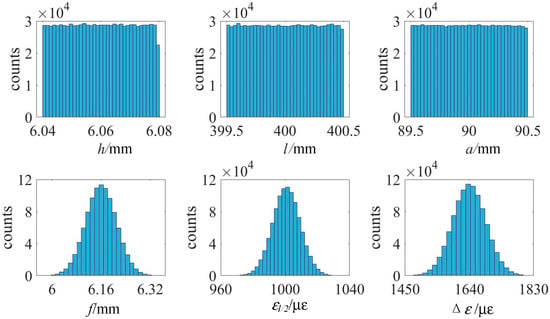
Figure 7.
Frequency distribution histogram of variables for MCM.
The distribution function, estimated value, and standard uncertainty of are calculated through the mathematical model. The coverage interval at 25 °C is obtained, which is [3.09, 3.49]. Figure 8 shows the frequency distribution histogram and PDF curve of output . The two vertical lines indicate the endpoint values of the coverage interval at 95% probability.
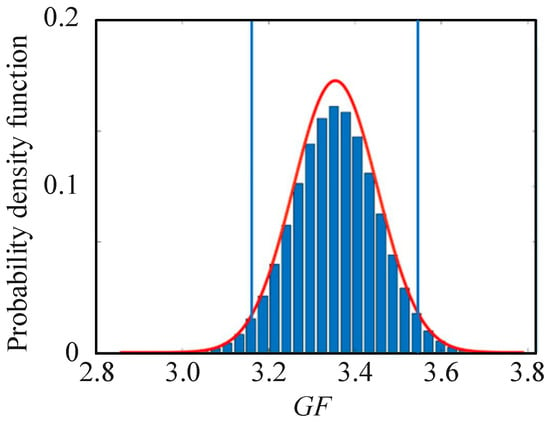
Figure 8.
The probability distribution by MCM calculates.
Based on the same MCM program, the of different temperature nodes in the range of 25 °C to 900 °C is calculated. The relationship between the estimated value and its uncertainty coverage interval with temperature variation, as well as the relationship between dispersion and temperature are obtained, as shown in Figure 9. Through simulation experiments, large-scale samples can be obtained from MCM, so that the obtained coverage interval is more stable and has less fluctuation. The figure shows that the dispersion of gradually increases with the increase in temperature. The dispersion of is 6.1% at 25 °C. When the temperature rises to 900 °C, the dispersion of increases to 21.8%. Since the material properties vary with temperature, the general trend of dispersion should increase with increasing temperature, and the MCM evaluation results are consistent with this fact.
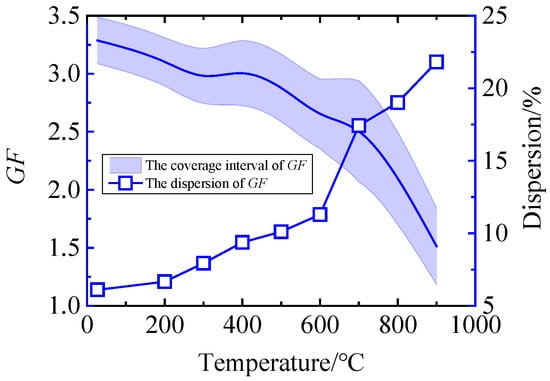
Figure 9.
Uncertainty interval and dispersion of obtained by MCM.
4.5. Comparison Between GUM and MCM
In the field of measurement, GUM and MCM are the mainstream methods for evaluating measurement uncertainty. MCM is based on probability and statistics theory, and its application scope is wider and its credibility is higher. In order to find a more suitable method for evaluating uncertainty, the analysis results of GUM and MCM are compared. Figure 10 and Figure 11 show the relationship between the uncertainty intervals obtained by GUM and MCM and the of each strain gauge measured experimentally (Figure 5). It can be seen from Figure 10 that at the specified calibration point, the uncertainty coverage interval obtained by GUM cannot contain all the experimental results, and the distortion is large. It can be seen from Figure 11 that at all calibration points, the uncertainty coverage interval obtained by MCM can contain the values obtained from the experiments and will not be too large. The uncertainty evaluation result of MCM is closer to the real situation, and the reliability is higher. MCM is superior to the GUM, which only uses prior information for uncertainty evaluation.
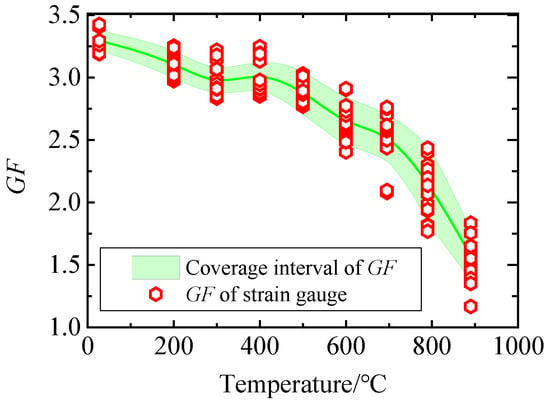
Figure 10.
Uncertainty interval obtained by GUM and of each strain gauge.
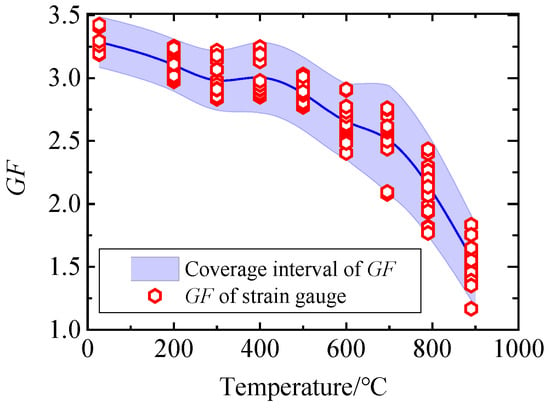
Figure 11.
Uncertainty interval obtained by MCM and of each strain gauge.
To further verify the reliability of the GUM evaluation results, the numerical tolerance verification is carried out using MCM. According to the above analysis, the uncertainty of is about 6.1% at 25 °C. When one significant digit is taken, that is, , then the value of is . The and at different temperatures can be calculated from Equations (12) and (13), as shown in Figure 12. The figure shows that GUM fails to pass the verification at different calibration temperatures, and GUM is not suitable for the uncertainty analysis of . MCM has no nonlinear restrictions on the model and is not affected by the correlation of input quantities and the complexity of the model. Therefore, MCM can overcome the defects and shortcomings of GUM in evaluating complex models and obtain more reliable measurement uncertainty evaluation.
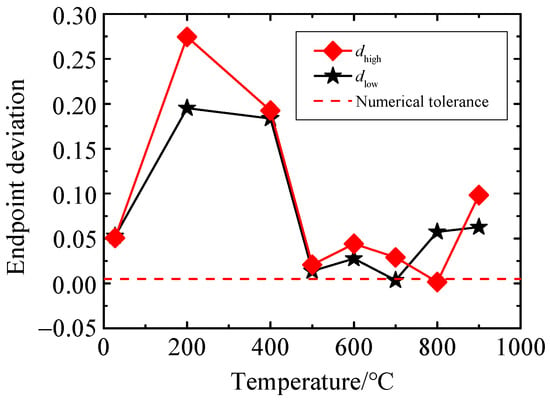
Figure 12.
Endpoint deviation value of the interval.
According to the above comparison, MCM is more suitable for the uncertainty evaluation of high-temperature strain gauges. In order to supplement the deficiency of MCM and find the main source of uncertainty quantitatively, further research is needed.
5. Analysis of Uncertain Sources
The calibration test of is affected by various factors, including the manufacturing and installation errors of the strain gauges and specimen, the equipment testing error, the nonlinear changes in material properties with temperature, and the temperature error. These errors are reflected in the mathematical model Equation (3) as follows: error of measuring strain with strain meter, error of measuring , , , deflection error of measuring with micrometer, error of measuring temperature with thermocouple, etc. From the above analysis, GUM is not suitable for evaluating the uncertainty of calibration tests. The calculation of the major uncertain source is not involved in the evaluation process of MCM. In order to quantitatively evaluate the major uncertain source, the following analysis is carried out.
5.1. The Influence of on the
According to the calculus theory, the influence of various factors on is related to the derivative of the mathematical model Equation (3) with respect to a single variable. Let be defined as the sensitivity. The relationship between sensitivity and can be calculated from Equation (12):
Similarly, the sensitivity of to other design variables is as follows:
The dependence of sensitivity on temperature is shown in Figure 13. It can be seen that and are large and decrease as the temperature increases. is about 0.54 at 25 °C and is reduced to 0.25 when the temperature reaches 900 °C. However, , , and are very small; they are all less than 0.02. Therefore, , , and have little influence on , but is sensitive to and .
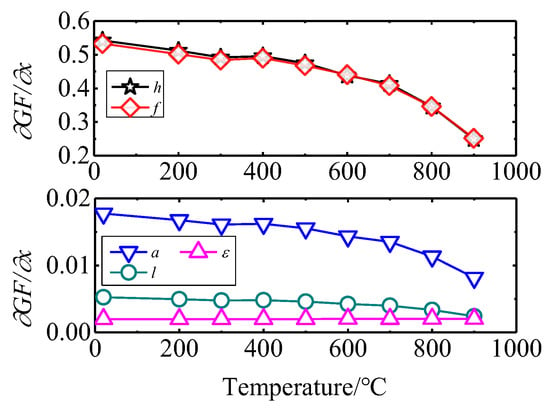
Figure 13.
The sensitivity of to the design variables.
5.2. The Influence of the Uncertainty of the Input on
The uncertainty of each input has a range. and are measured by meter ruler, the uncertainty is [±0.05, ±0.5] mm. is measured by vernier calipers, and the uncertainty is [±0.02, ±0.05] mm. is measured using a dial indicator with an uncertainty of [0.004, 0.018] mm. is measured by strain meter, with an uncertainty of [15, 75] με. As the temperature rises, the measurement uncertainty will be affected by temperature and thermal expansion coefficient, etc.
The relationship between the uncertainty of each input and the uncertainty of is obtained by the MCM program, as shown in Figure 14. It can be seen from Figure 14a that increases with the increase in , but the increased effect is not significant, and increases from 0.0486 to 0.0503. As shown in Figure 14b, the increases in in its error range results in a weak increase in in the range of 0.0485~0.0488. The uncertainty of has no effect on . As can be seen from Figure 14c, with the increase in , the increase in is not significant, increasing from 0.0486 to 0.0494. Figure 14d indicates that increases linearly with the increase in . When is 15 με, is 0.0312, and when reaches 75 με, reaches 0.1503. Therefore, has the greatest influence on .
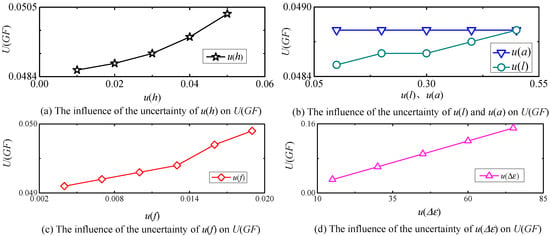
Figure 14.
The influence of the uncertainty of each factor on .
5.3. The Influence of the PDF of Each Factor on
From the previous analysis, it can be assumed that is the major uncertain source in the evaluation of the gauge factor . Therefore, it is expected that the PDF of will also change significantly for different PDFs of . To prove this fact, different PDFs are assigned to the input and their effect on the PDF of the output is studied.
Figure 15 shows the assumed distribution and the corresponding frequency distribution of the output . As can be seen from the figure, the distribution of is strongly correlated with the distribution of . Firstly, is assumed to be trapezoidal distribution (Figure 15a), which leads to the output tending to be a trapezoidal distribution. The mean value is 3.28, which is little changed from the normal distribution. The uncertainty interval is wider, and the uncertainty is about 0.24. In addition, the cases where is triangular distribution and rectangular distribution are analyzed, and the analysis results are shown in Figure 16. When the means of the input quantities are the same, the distribution function of has little influence on the mean of , in the range of 3.275~3.280. When is normally distributed, , which is the smallest value, and the uncertainty interval is the narrowest. When is a rectangular distribution, the uncertainty interval is the widest, which is 0.28. For convenience of calculation, let when is normally distributed. When is trapezoidal distribution, let . When is triangular, . Let when is uniformly distributed.
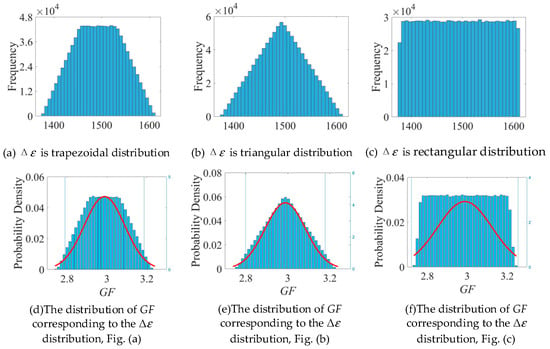
Figure 15.
The influence of distribution of on distribution of .
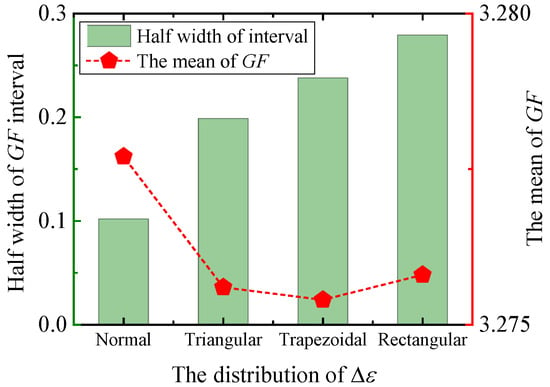
Figure 16.
The influence of the distribution of on the uncertainty of .
Through the above analysis, the derivative of the mathematical model with respect to each input, the uncertainty of each input, and the PDF of each input all affect the uncertainty . Therefore, the concept of the weight coefficient is proposed as the criterion to judge the major uncertain source. The weight coefficient is expressed by Formula (17):
At different temperatures, the weight coefficients of each input is calculated by Equation (17), and the results are shown in Figure 17. As can be seen from the figure, the weight coefficients of and are larger, while the values of the other three input quantities are smaller. This is particularly prominent when the temperature is higher than 300 °C. Therefore, is the major uncertain source.
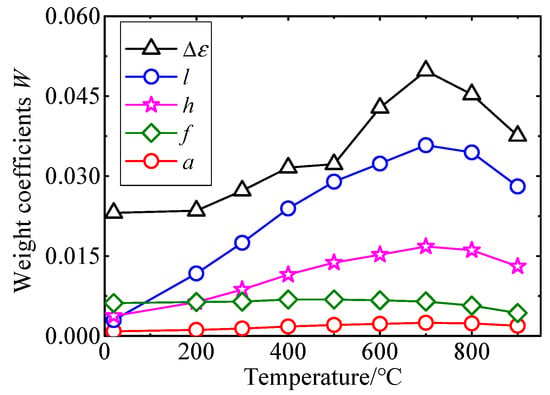
Figure 17.
Weight coefficients of each input at different temperatures.
6. Conclusions
In this paper, the calibration test of high-temperature strain gauge was carried out, and the uncertainty of the test results was evaluated by GUM and MCM, respectively. The influence of each input on the uncertainty of was studied, and the concept of weight coefficient was proposed. The conclusions are as follows:
- (1)
- The calibration test results of the high-temperature strain gauge show that the decreases with the increase in temperature nonlinearly. At 25 °C, is about 3.29, and when the temperature reaches 900 °C, decreases to 1.6.
- (2)
- GUM and MCM are used to evaluate the uncertainty of the calibration test, and the results are compared and analyzed. The uncertainty obtained by GUM is too small, but it cannot cover all the test results and cannot accurately characterize the true dispersion of . The endpoint deviation values are all greater than the numerical tolerance, that is, GUM has not passed the verification and is not suitable for the uncertainty evaluation of the strain gauge .
- (3)
- MCM can obtain more samples through large-scale stochastic numerical simulation. The evaluation results can be better matched with the test results, and the evaluation results are more accurate and effective. The dispersion is 6.1% at 25 °C, and it reaches 21.8% when the temperature rises to 900 °C.
- (4)
- The concept of weight coefficient is proposed, which includes the sensitivity of the mathematical model to each input, the uncertainty of each input, and the PDF of each input. The analysis proves the influence of the three aspects on , which can be an effective supplement to MCM, and the major uncertain source in the mathematical model can be quantitatively analyzed. The uncertainty evaluation can be applied to other fields and provides important information for improving the stability of the installation process.
Although this study has made some achievements, it is still limited to the post-processing of the experimental results. It is expected that the stochastic finite element method will be used to analyze the structural uncertainty theoretically in the future.
Author Contributions
Methodology, J.T.; Validation, Z.W.; Investigation, Y.A.; Writing—original draft, Y.Z.; Writing—review & editing, F.Z. All authors have read and agreed to the published version of the manuscript.
Funding
Project of Liaoning Provincial Department of Education: JYTMS20230250; National Natural Science Foundation of China (Grant No. 12172231).
Institutional Review Board Statement
Not applicable.
Informed Consent Statement
Not applicable.
Data Availability Statement
Data are contained within the article.
Conflicts of Interest
The authors declare that they have no known competing financial interests or personal relationships that could have appeared to influence the work reported in this paper.
Appendix A

Table A1.
The strain measurement results for loading and unloading at different temperatures.
Table A1.
The strain measurement results for loading and unloading at different temperatures.
| T/°C | First Load: Deflection/Strain (mm/με) | Second Load: Deflection/Strain (mm/με) | Third Load: Deflection/Strain (mm/με) | |||||||||||||||
|---|---|---|---|---|---|---|---|---|---|---|---|---|---|---|---|---|---|---|
| 25 | 6.161 | 6.218 | 6.114 | |||||||||||||||
| 1596 | 1599 | 1630 | 1647 | 1705 | 1712 | 1611 | 1613 | 1647 | 1664 | 1722 | 1728 | 1585 | 1587 | 1620 | 1636 | 1696 | 1701 | |
| 200 | 6.156 | 6.161 | 6.243 | |||||||||||||||
| 1487 | 1494 | 1533 | 1544 | 1608 | 1612 | 1502 | 1508 | 1537 | 1531 | 1594 | 1627 | 1539 | 1530 | 1582 | 1577 | 1631 | 1643 | |
| 300 | 6.171 | 6.166 | 6.148 | |||||||||||||||
| 1451 | 1473 | 1478 | 1494 | 1577 | 1537 | 1430 | 1420 | 1468 | 1477 | 1612 | 1535 | 1456 | 1425 | 1452 | 1454 | 1587 | 1532 | |
| 400 | 6.146 | 6.177 | 6.082 | |||||||||||||||
| 1428 | 1441 | 1473 | 1474 | 1621 | 1577 | 1431 | 1444 | 1459 | 1471 | 1592 | 1572 | 1447 | 1439 | 1455 | 1471 | 1578 | 1576 | |
| 500 | 6.096 | 6.094 | 6.261 | |||||||||||||||
| 1385 | 1372 | 1377 | 1421 | 1493 | 1488 | 1383 | 1394 | 1405 | 1434 | 1464 | 1499 | 1438 | 1426 | 1426 | 1458 | 1471 | 1532 | |
| 600 | 6.057 | 6.010 | 6.000 | |||||||||||||||
| 1258 | 1237 | 1232 | 1307 | 1183 | 1365 | 1288 | 1273 | 1284 | 1348 | 1220 | 1418 | 1330 | 1315 | 1331 | 1352 | 1211 | 1419 | |
| 700 | 6.105 | 6.114 | 6.176 | |||||||||||||||
| 1251 | 1223 | 1209 | 1263 | 1031 | 1340 | 1278 | 1261 | 1242 | 1291 | 1038 | 1367 | 1294 | 1291 | 1303 | 1313 | 1051 | 1385 | |
| 800 | 6.076 | 6.026 | 6.078 | |||||||||||||||
| 954 | 898 | 895 | 1030 | 873 | 1135 | 1081 | 1033 | 972 | 1057 | 951 | 1175 | 1118 | 1044 | 1021 | 1085 | 1055 | 1202 | |
| 900 | 6.016 | 5.999 | 6.038 | |||||||||||||||
| 728 | 707 | 666 | 754 | 793 | 896 | 783 | 732 | 661 | 726 | 804 | 855 | 714 | 682 | 572 | 663 | 761 | 809 | |
References
- Staab, G.H. Mechanical Test Methods for Lamina. In Laminar Composites; Elsevier: Amsterdam, The Netherlands, 2015; pp. 99–138. [Google Scholar]
- Wrbanek, J.; Fralick, G.; Martin, L.; Blaha, C. A Thin Film Multifunction Sensor for Harsh Environments. In Proceedings of the 37th Joint Propulsion Conference and Exhibit, Salt Lake City, UT, USA, 8–11 July 2001. [Google Scholar]
- Otto, J.; Gregory, Q.L. A self-compensated ceramic strain gage for use at elevated temperatures. Sens. Actuators A Phys. 2001, 88, 234–240. [Google Scholar]
- Hao, Z.; Chen, G. Characterization of out-of-plane tensile stress–strain behavior for GFRP composite materials at elevated temperatures. Compos. Struct. 2022, 290, 115477. [Google Scholar] [CrossRef]
- Teppernegg, T.; Klünsner, T. High temperature mechanical properties of WC–Co hard metals. Int. J. Refract. Met. Hard Mater. 2016, 56, 139–144. [Google Scholar] [CrossRef]
- Zhao, Y.; Zhang, F.; Ai, Y.; Tian, J.; Wang, Z. Structural uncertainty analysis of high-temperature strain gauge based on Monte Carlo stochastic finite element method. Sensors 2023, 23, 8647. [Google Scholar] [CrossRef]
- Yang, S.; Li, H. Effect of Al2O3/Al bilayer protective coatings on the high-temperature stability of PdCr thin film strain gages. J. Alloys Compd. 2018, 759, 1–7. [Google Scholar] [CrossRef]
- Schmid, P.; Zarfl, C.; Balogh, G.; Schmid, U. Gauge Factor of Titanium/Platinum Thin Films up to 350 °C. Procedia Eng. 2014, 87, 172–175. [Google Scholar] [CrossRef][Green Version]
- ISO/IEC 98-3; Uncertainty of Measurement—Part 3: Guide to the Expression of Uncertainty in Measurement. ISO: Geneva, Switzerland, 2010.
- Zhang, F.; Zhang, X.; Ai, Y. Sensitive grid structure optimization of high temperature strain gauge based on response surface methodology. Chin. J. Sci. Instrum. 2023, 44, 144–155. [Google Scholar]
- El Fazani, H.; Coil, J.; Chamberland, O.; Laliberte, J. Determination of experimental uncertainties in tensile properties of additively manufactured polymers using the GUM method. Measurement 2022, 202, 111726. [Google Scholar] [CrossRef]
- Chen, Y.; Li, X.; Huang, L.; Wang, X.; Liu, C.; Zhao, F.; Hua, Y.; Feng, P. GUM method for evaluation of measurement uncertainty: BPL long wave time service monitoring. Measurement 2022, 189, 110459. [Google Scholar] [CrossRef]
- Song, M.S.; Fang, X.H.; Huang, J. Research on the measurement uncertainty evaluation method of infinitesimal sample in calibration and testing. Chin. J. Sci. Instrum. 2014, 35, 419–426. [Google Scholar]
- JCGM 101:2008; Evaluation of Measurement Data—Supplement 1 to the Guide to the Expression of Uncertainty in Measurement—Propagation of Distributions Using a Monte Carlo Methodt. Available online: https://www.iso.org/obp/ui/en/#iso:std:iso:guide:98:-3:ed-1:v2:suppl:1:v1:en (accessed on 23 January 2025).
- González, C.; Vilaplana, J.M.; Parra-Rojas, F.C.; Serrano, A. Validation of the GUM uncertainty framework and the Unscented transformation for Brewer UV irradiance measurements using the Monte Carlo method. Measurement 2025, 239, 115466. [Google Scholar] [CrossRef]
- Jiang, W.S.; Li, X.; Luo, Z. Uncertainty evaluation of calibration model of six DOF robot arm. Chin. J. Sci. Instrum. 2022, 43, 26–34. [Google Scholar]
- Huang, M.F.; Jing, H.; Kuang, B. Measurement uncertainty evaluation based on quasi MonteCarlo method. Chin. J. Sci. Instrum. 2009, 30, 120–125. [Google Scholar]
- Singh, J.; Kumaraswamidhas, L.A.; Bura, N.; Sharma, N.D. A Monte Carlo simulation investigation on the effect of the probability distribution of input quantities on the effective area of a pressure balance and its uncertainty. Measurement 2021, 172, 108853. [Google Scholar] [CrossRef]
- Forster, M.; Seibold, F.; Krille, T.; Waidmann, C.; Weigand, B.; Poser, R. A Monte Carlo approach to evaluate the local measurement uncertainty in transient heat transfer experiments using liquid crystal thermography. Measurement 2022, 190, 110648. [Google Scholar] [CrossRef]
- Rost, K.; Wendt, K.; Härtig, F. Evaluating a task-specific measurement uncertainty for gear measuring instruments via Monte Carlo simulation. Precis. Eng. 2016, 44, 220–230. [Google Scholar] [CrossRef]
- Motra, H.B.; Hildebrand, J.; Wuttke, F. The Monte Carlo Method for evaluating measurement uncertainty: Application for determining the properties of materials. Probabilistic Eng. Mech. 2016, 45, 220–228. [Google Scholar] [CrossRef]
- Sepahi-Boroujeni, S.; Mayer, J.R.; Khameneifar, F. Prompt uncertainty estimation with GUM framework for on-machine tool coordinate metrology. Procedia CIRP 2022, 112, 117–121. [Google Scholar] [CrossRef]
- Wang, W.; Song, M.S.; Chen, Y.H. Application of Monte-Carlo method in measurement uncertainty evaluation of complicated model. Chin. J. Sci. Instrum. 2008, 29, 1446–1449. [Google Scholar]
- Castro, H.F. Validation of the GUM using the Monte Carlo method when applied in the calculation of the measurement uncertainty of a compact prover calibration. Flow Meas. Instrum. 2021, 77, 101877. [Google Scholar] [CrossRef]
- Chen, A.; Chen, C. Comparison of GUM and Monte Carlo methods for evaluating measurement uncertainty of perspiration measurement systems. Measurement 2016, 87, 27–37. [Google Scholar] [CrossRef]
- Reis, M.L.; Castro, R.M.; Mello, O.A. Calibration uncertainty estimation of a strain-gage external balance. Measurement 2013, 46, 24–33. [Google Scholar] [CrossRef]
- Teomete, E. Measurement of crack length sensitivity and strain gage factor of carbon fiber reinforced cement matrix composites. Measurement 2015, 74, 21–30. [Google Scholar] [CrossRef]
- GB/T 13992-2010; Metallic Bonded Resistance Strain Gauges. China Testing Technology Research Institute: Shanghai, China, 2010.
- E0251-20A; Standard Test Methods for Performance Characteristics of Metallic Bonded Resistance Strain Gages. iTeh Standards: Newark, DE, USA, 2014.
- Ai, Y.; Liu, M.; Zhang, F. Research on the structural optimization method to improve the service life and accuracy of high temperature strain gauge. Chin. J. Sci. Instrum. 2022, 43, 28–38. [Google Scholar]
- Gregory, O.J.; Chen, X. Strain and temperature effects in indium–tin-oxide sensors. Thin Solid Film. 2010, 518, 5622–5625. [Google Scholar] [CrossRef]
Disclaimer/Publisher’s Note: The statements, opinions and data contained in all publications are solely those of the individual author(s) and contributor(s) and not of MDPI and/or the editor(s). MDPI and/or the editor(s) disclaim responsibility for any injury to people or property resulting from any ideas, methods, instructions or products referred to in the content. |
© 2025 by the authors. Licensee MDPI, Basel, Switzerland. This article is an open access article distributed under the terms and conditions of the Creative Commons Attribution (CC BY) license (https://creativecommons.org/licenses/by/4.0/).